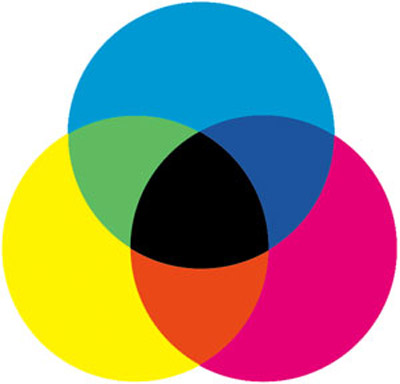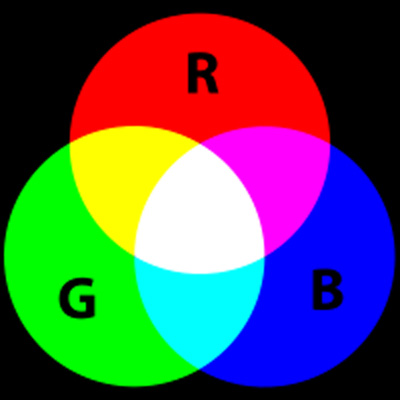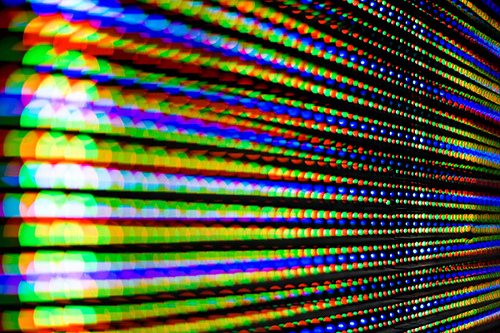What is the difference between RGB and CMYK? These color acronyms can be tricky to navigate sometimes! Fundamentally, RGB and CMYK are different color processes. They describe the actual design and printing process itself. Still confused? Want to know the difference? Then read on…
Lets start by examining RGB and CMYK individually
What is CMYK?


CMYK stands for 4 different pigments: Cyan, Magenta, Yellow and Black. Why does the K in CMYK stand for black? Well the B that would be used for black was superseded by the B of blue, so the last letter – K – was taken instead. Tough luck black. Anyway, CMYK is a subtractive printing process. It is all to do with how much light can be reflected back from the white paper. This is actually a very simple concept.
If you imagine that you are starting with a pure white piece of paper. Now imagine that you print thousands of tiny black pixels/dots of pigment evenly across 50% of the paper area. What is the result? To the eye, it is now a piece of grey paper. The reason for this is that 50% of the white paper is unable to reflect back to your eye because it is blocked by the black pigment. It should be easy to imagine that if you increase the area that the black dots are spread over to 90%, you will end up with a substantially (40%) darker grey. It’s all to do with dot concentration and the whiteness of the paper.
Lets take this on slightly, now imagine the dots are cyan instead of black. The pigment being used here will actually stop only certain colors in the full-color spectrum from being reflected back from the white page- don’t forget that white is the sum of all colors. In cyan’s case all colors bar blue are restricted so by varying the dot concentration of cyan ink allows you to vary the ‘blueness’ of our piece of paper. Magenta does the same but for red. And yellow does the same for…yellow. It is by mixing the dot concentration of these three pigments that we actually achieve the full spectrum of color in the CMYK color printing process.
Interestingly, black is not 100% necessary in the whole process. CMY covers the entire color spectrum so if you were to have 100% dot concentration of all three pigments across our lovely piece of white paper, you would in fact have a lovely piece of black paper. Don’t forget that black is the absence of all color so in this instance you would be preventing the white paper from reflecting any light back. You would be subtracting all the color. The obvious question now is ‘why does CMYK include black at all?’ Well it is quite simple- black adds a lot of value. When it comes to printing detailed, small or precise black elements in a design, it is substantially easier to use just one pigment- black. In order to achieve the same affect with our imaginary CMY you would have to print on a precise point 3 separate times. Since the print process does have some, albeit small, margins for error, the results would be smudgy text. Not a great idea. Along the same vein, black actually allows for a wide spectrum of crisp grays to be printed within a design. Finally, it can reduce the amount of ink that is actually printed onto a page. If you were printing a fully black piece of paper using CMY, you would actually be putting 3 times more ink on that if you just used black. When it comes to printing black backgrounds on thin paper stocks this can actually cause the paper to crinkle and warp as the inks dries. Not ideal!
One interesting method that is allowed by using the subtractive CMYK technique is the alteration of tones via the alteration of the paper being used. Don’t forget, it is actually variations the light bouncing off the paper coming back to your eye that creates the color you see in the printing. If you change the color of the paper then you alter the tones and feeling of the light coming back to you. Take nice creamy-white card used in wedding invitations, these allows for warmer and deeper color tones. Similarly, blue allows for more clinical and crisper tones to develop. So by changing the paper and changing the ink concentration, the CMYK color process allows for an almost infinite range of color printing.
What is RGB?

What does RGB stand for? Red, Green and Blue- the primary colors.
Now that we know that CMYK is a subtractive color process, it might be easiest to understand RGB as an additive color process. So whereas with CMYK we started with all the colors (white) and subtracted different parts of the spectrum, with RGB we start with no color whatsoever (black) and add them on. Turns out that a ‘blank canvas’ is actually black. The key difference here is that CMYK relies on the existence of light to bounce off the paper whilst RGB assumes no light and requires artificial light sources to kick the color process off. We can understand therefore that whilst CMYK has its routes in the color printing process, RGB actually pertains to the production of color in electronic systems. RGB is a color model that is device-dependent. A vast array of screens and display modules are reliant on the RGB color model to produce color. You’re looking at it in action right now.
Again, whilst CMYK starts with white, RGB starts with black and adds color on. Different shades of red, green and black are added to a display with an electronic source: a cathode ray tube, a liquid crystal diode, or other electronic displays.

RGB relies on each of the primary colors changing their shades. Each shade can be changed 256 times meaning that 16,777,216 on-screen colors can be generated using this process (256 x 256 x 256). When all the colors are turned to 256, you have a white screen. When all the colors are turned to 0…you guessed it.
What is the difference between RGB and CMYK?
Well is should be obvious from the above that RGB and CMYK are two sides of the same coin. However, they both rely on the alteration in light and shades of base colors to provide different a huge variation in sum color.
But what are the differences in practical application of each of these color processes? What is CMYK used for and what is RGB used for? Well, as already explained, RGB is an on-screen color process whilst CMYK is used in domestic and commercial printing. We think you should know the difference, which is why we’ve been harping on for a while now. It especially has implications in the design process. If you are putting together a lovely flyer or poster design in any of the major design programs out there, you will be able to change the color mode from RGB to CMYK (displaying CMYK on-screen is actually a very fancy bit of technology). It is important if you are designing for print that you are using CMYK because there will be a difference in the finished printed product. It’s all to do with color shifts. Most notably, black can be an issue when design in RGB and printing in CMYK. RGB does not contain a black pigment, unlike CMYK, so when conversion takes place you might well end up with what is known as a rich-black where, as explained earlier, CYM is combined to produce the black pigment. Too much ink on the page and smudgy details etc. etc. Finally, your printer will probably shout at you because all commercial printers will be using the CMYK process and won’t want to take responsibility when the finished article looks slightly different.
So there we go. That is the difference between RGB and CMYK. If you didn’t know, now you do!
Best Wishes,
The StuPrint.com Team
StuPrint.com brings you budget-friendly rates on a wide range of diligently printed print marketing materials, including premium brochures, booklets, menus, leaflets, flyers, posters, stickers, letterheads, calendars, roller banners and business cards.
MORE ARTICLES!
Do you already have your print campaign in mind? Then its time to get your artwork print ready. This handy little blog article will help
Taking on a designer to put together your flyer artwork? Learn how to write a great flyer brief by clicking here
Flyers, flyers, flyers- find out how they can help your business or brand by clicking here
Printing flyers? This great little article has some top tips from one of our more experienced (elderly) print gurus
Resolution and understanding DPI is really important to get your artwork as crisp as can be. Have a read through this for an explanation
Confused by the print industry? You’re not alone. We put together a glossary of terms to help you break down the print jargon
Here at StuPrint we work with 3mm bleeds to make sure your print comes out great. Find out what this is here
